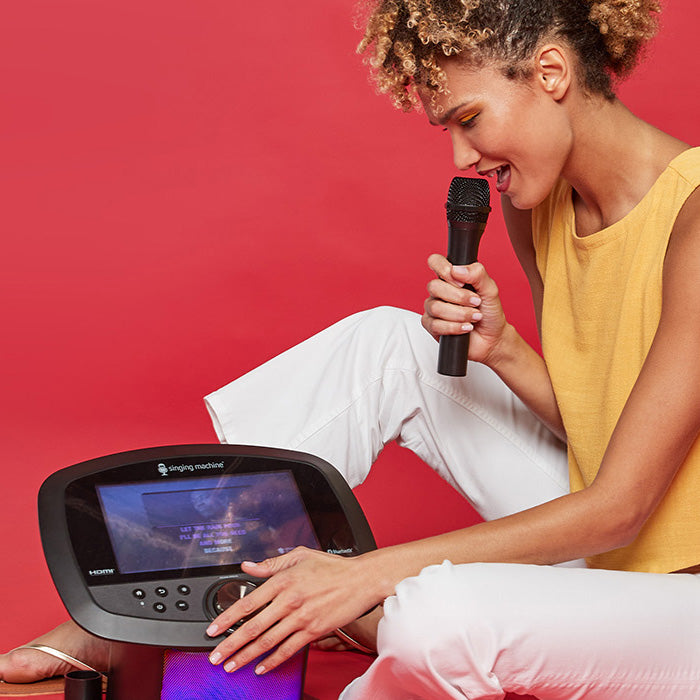In addition to all of the terminology associated with consumer electronic products, a few additional terms are used almost exclusively in karaoke. These terms are meant to familiarize you with the world of Karaoke. The features listed below may not necessarily pertain to the particular Singing Machine that you have. The following are some brief explanations of karaoke terms.
Audio Out: output jack on a system which allows for the audio to be played through another system (as in for running the sound through a house p.a. or speakers)
CDG or CD+G: this is an acronym for Compact Disc plus Graphics. You will also see variations CD+G and CD+Graphics. This is a regular CD with information stored on a data track simultaneous to music. In la
Digital Key Controller: raises or lowers the key/pitch of a song to help you sing notes which are too high or too low for your vocal range. (Typically, this is done for the whole song, not just a single passage or note)A pitch controller changes the key by slowing down or speeding up the recording. A Digital key changer changes the key without effecting the speed/tempo of the music.
DVD (Digital Video Disc): a high-density compact disc format which, for karaoke use, can incorporate a motion picture or moving background and the song lyrics superimposed in front of the video pictures.
Echo: echo adds depth and resonance to a singer’s voice. This echo is produced by creating minor controlled feedback in the singer’s voice. The echo function does not affect the music.
Headphone Output: microphone jack that allows the music to be heard through headphones.
Inputs: input jacks which allow for connecting other components or systems to the main system.
Karaoke: a Japanese word which loosely translates as “empty orchestra,” describing the concept of providing a singer with background accompaniment music (usually including background/harmony vocals). The karaoke industry provides both software (cassettes, compact disc, compact discs with graphics, DVD disc, etc.) and hardware, the main features of which include echo, microphone mixing functions, etc. described in this glossary.
Karaoke Mixer: the basic component of karaoke hardware, this allows a singer’s voice to be mixed with music. Adds echo and special effects; sometimes includes key changer.
Line Out: allows connection of the karaoke system to other systems (speakers, home studios, etc.)
Monitor: TV Screen used to display words and/or pictures from CDGs, laser discs, or videos by hooking up to the CD+G/DVD player.
Multiplex: as a term for karaoke, this is a format in which the Lead Vocal is recorded/played back on one channel only and the music is on the other channel. When the multiplex feature on the karaoke machine is activated, this allows for either voice only or music only playing by controlling the left/right balance of a stereo system. For example, if the karaoke singer stops singing into the microphone, the multiplex feature will activate the pre-recorded demonstration vocal to fill in, in place of the live karaoke singer. When the karaoke singer resumes singing, the pre-recorded voice is deactivated.
Omni-Directional Microphone: sound pick-up pattern is wide and fan-like. Works well to more evenly pick up two or more singers’ voices (can be placed in front of a group for a more even distribution of sounds coming from the sides of the microphone)
Pitch/Speed Control: raises or lowers the song key/pitch to help you sing a note which is too high or too low for your vocal range. A pitch controller changes the key by slowing down or speeding up the recording. A Digital key changer changes the key without effecting the speed/tempo of the music.
Stereo Balance Control: left/right channel balance on a stereo system; allows you to remove the lead vocal example on multiplex recordings by turning off one channel.
Tone Control: bass/treble sound control.
Uni-Directi pick-up pattern is narrow and ideal for a solo singer (does not tend to pick up sounds to the sides of the microphone, reduces possibility of feedback).
Video Out
Output: jack on a system which allows for the video to be shown on a TV/monitor.
Vocal Assist
Allows the lead vocal to be heard over headphones, without being heard over the speakers, when used with multiplex recordings
Vocal Reducer / Vocal Masking: decreases the volume of the recorded vocals on the compact disc so you can sing songs not yet released on karaoke recordings: amount of reduction varies with original recording .
Vocal Replacer: feature of a karaoke mixer which, when used with multiplex recordings, mutes the recorded vocals while you sing; when you stop, the recorded vocals will pick up where you left off (great for practicing)





